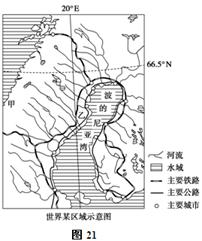读图21,完成下列问题。(12分)

(1)图中哪些区域会出现极昼极夜现象?为什么?(4分)
(2)分析海陆分布与地形对甲、乙两地气候形成的影响。(4分)
(3)简述该区域第四纪主要外力作用及对地表形态的塑造。(4分)
(1)66.5°N及其以北地区。原因:黄赤交角为23.5°,地球公转导致昼夜交替消失。
(2)甲地:温带海洋性气候(降水丰富,季节分配均匀,气温年较差小)。西临大西洋,盛行西风,山脉走向与海岸平行,迎风坡,暖流经过。乙地:温带大陆性气候(降水相对较少,集中在夏季,气温年较差较大)。背风坡,海域面积小,海洋水汽较少。
(3)冰川作用、流水作用。
西部海岸线曲折,多峡湾;湖泊广布,东部形成冰湖群;河流平行状排列,湖泊多位于河流中上游。
本题考查世界区域地理综合分析。(1)极昼极夜只出现在极圈以内,原因主要从黄赤交角的度数分析。(2)根据图示的经纬度位置判断该地区位于斯堪的纳维亚半岛,甲地位于西部沿海,受盛行西风和北大西洋暖流的影响,形成温带海洋性气候,终年温和湿润,而乙地位于斯堪的纳维亚山脉的东侧,为盛行西风的背风坡,故终年受大陆气体影响,而形成温带大陆性气候,终年降水少,冬寒夏热。(3)该地区主要的外力作用为冰川作用塑造的半岛西部沿海的峡湾地貌和众多的湖泊;和长期以来的流水作用。
